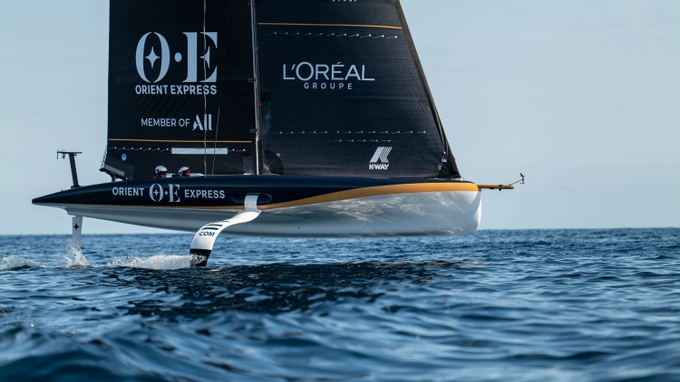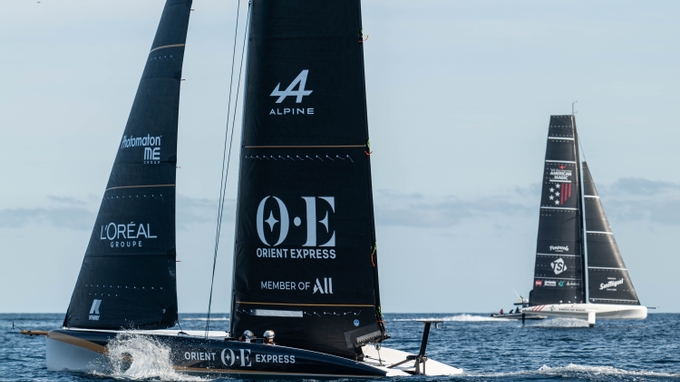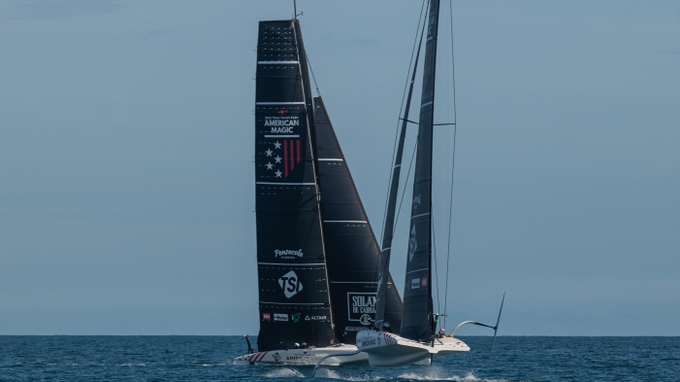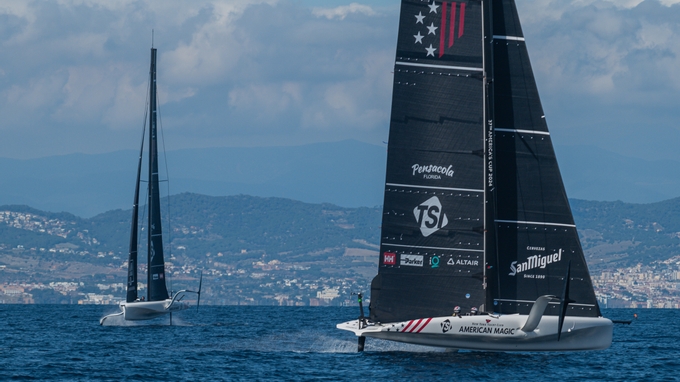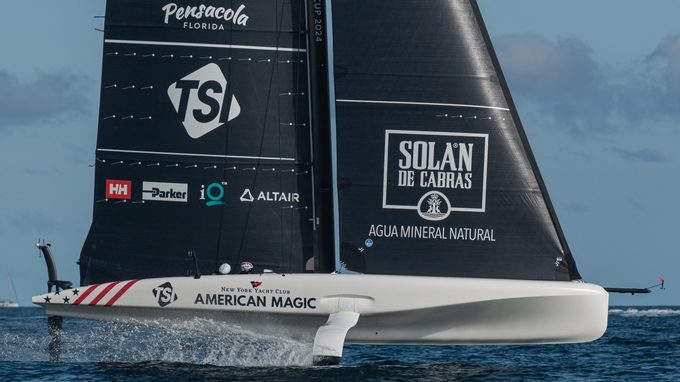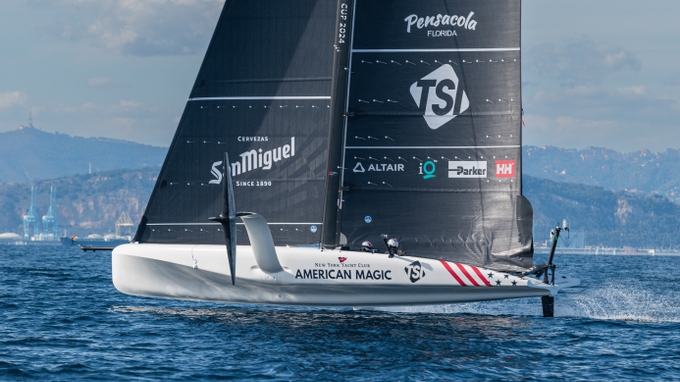FIGHT FOR FLIGHT IN SERENE BARCELONA
With a cluster of clouds sitting resolutely over the Sierra de Collserola and Montjuic hill ranges surrounding Barcelona, there was little chance of anything material building for Orient Express Racing Team and NYYC American Magic who were the only two teams to train this afternoon (Thursday).
Persistence paid once again though and both teams achieved valuable foiling time with the anemometer only briefly registering 8 knots and the median being in the 5-7 knot range with a smooth sea state. Mastering the light is certainly something that everyone is looking to hone and for the French it was another day of testing through pitch settings and transverse modes. Yesterday’s heavily bow-down mode was replaced by a less aggressive longitudinal one with more ‘standing’ on the foils and a noticeably increased ride height to coax the boat through deep-angled tacks and gybes.

The LEQ mainsail was once again aired with its deep camber being perfect ffor the flat water to induce the power and drive to keep the boat going through the patches whilst flattening off alarmingly fast when required. Sail design is one area the French will be eyeing, with plenty of experience shoreside to build fast, adaptable sails for the variety of conditions that they will encounter in the racing for the Louis Vuitton 37th America’s Cup.

Long day on the water again for the team and Kevin Peponnet came ashore alive with learnings saying: “It went pretty well it was really instructive for us, the wind was pretty light 6-7-8 knots maximum and dropping to six knots and sometimes we were not foiling at all. But we managed to pass some manoeuvres and to do some kind of racing alone...we are trying to feel the balance, different balance, changing the heel, changing the cant, changing the balance on the foils in the longitudinal on the trim. With this boat you have a lot of ability to change the balance and depends on the day. Today we were looking for more altitude to succeed in manoeuvres.”
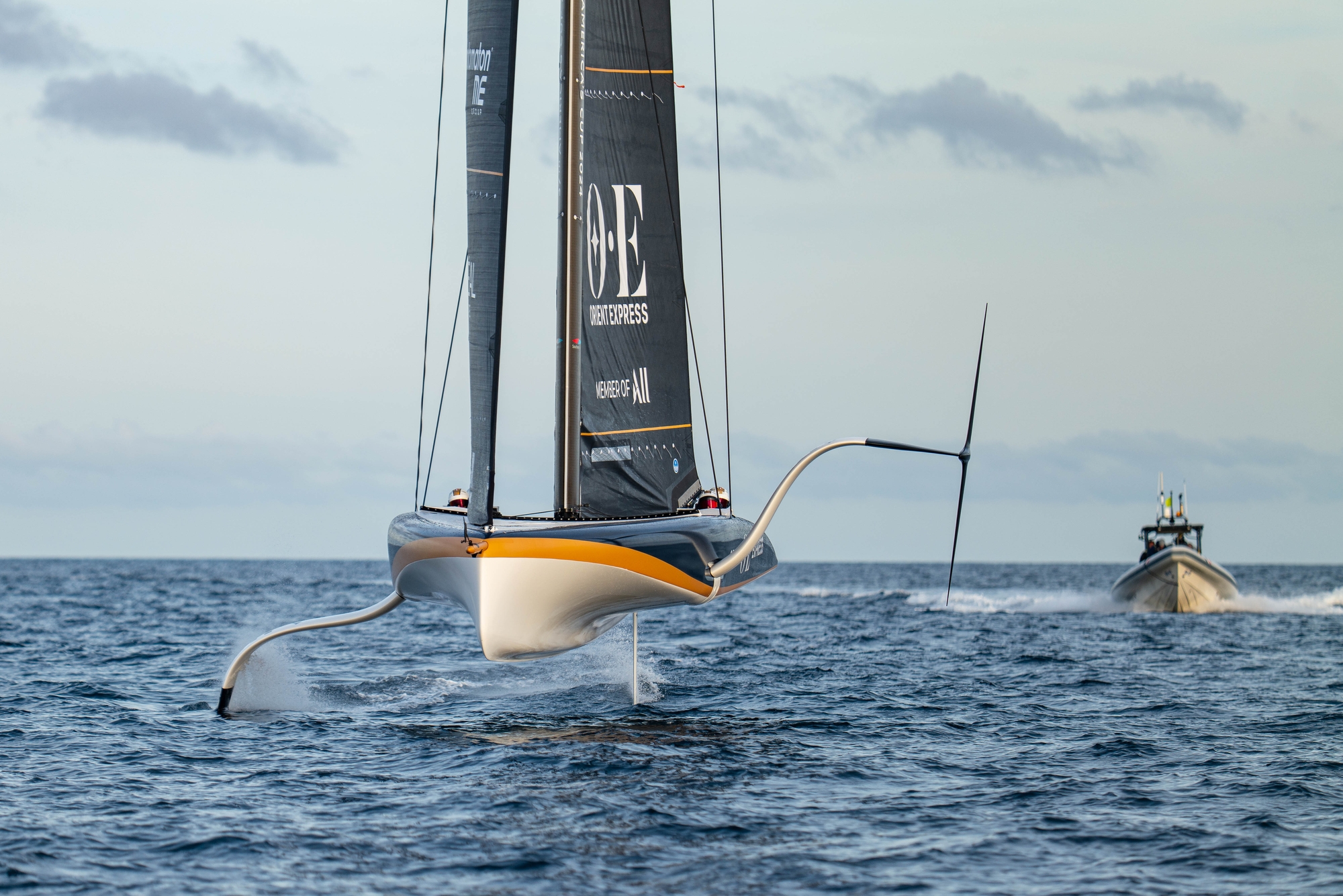
Talking about the influence that Glenn Ashby has brought to the campaign, Kevin was full of praise for the wily Australian who is acting a consultant capacity to Orient Express Racing, saying: “He’s brought us huge information and good knowledge from the previous campaigns he has made. He’s really good and really clear and he brought us a lot of info about how to trim the sails, about all the physics and he understands well how the physics works on this boat so we're talking about yeah like how to trim well the sail to get the right trim on exiting the manoeuvres, on the starts...he brought us, in the last four days, a lot of information that we have to digest.”
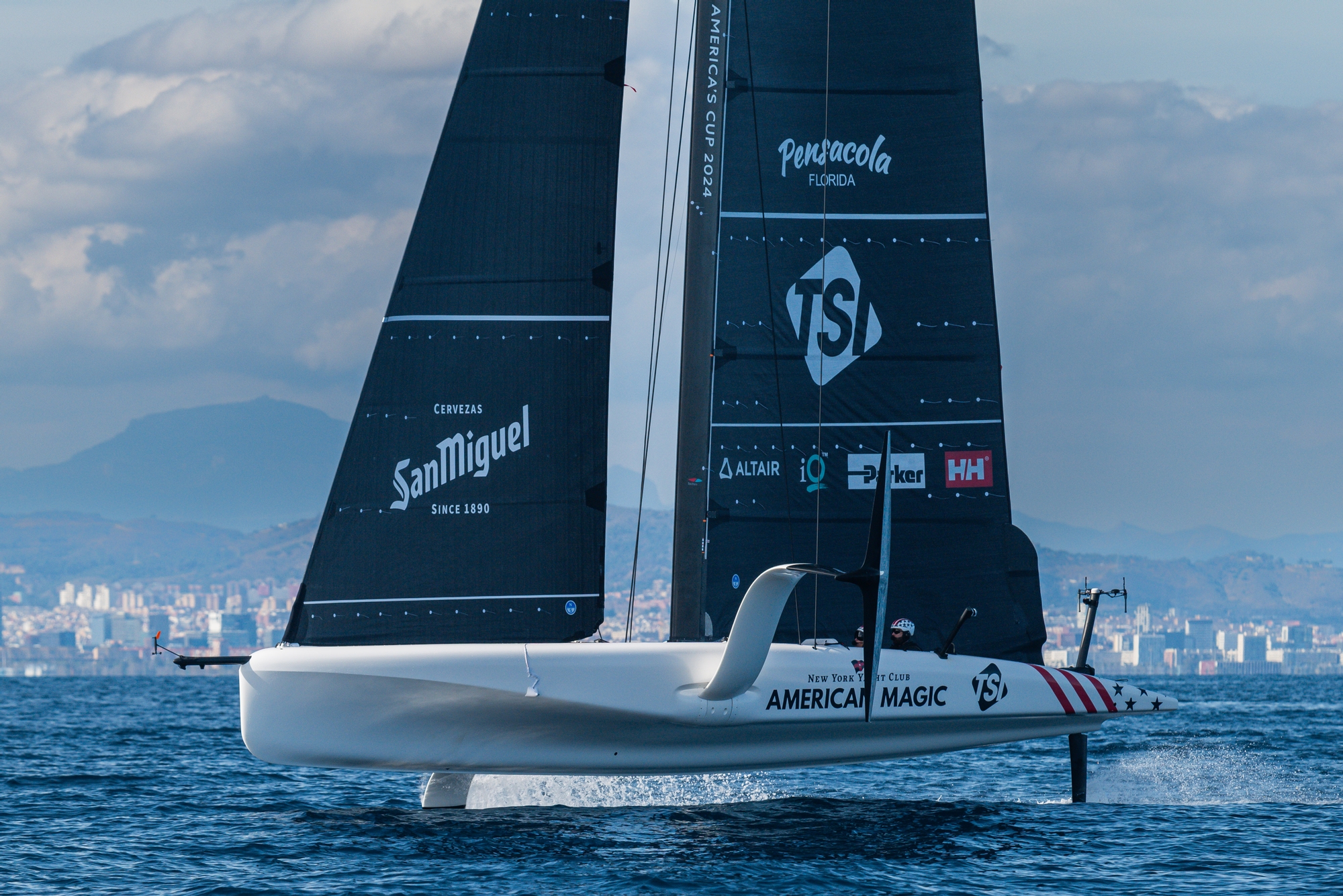
For NYYC American Magic, who sat out yesterday, today we saw a welcome return of ‘America’ that has spent a few days in the shed addressing the ‘crack’ as reported by Terry Hutchinson that appeared at the end of Monday’s session just forward of the port foil arm. Repaired and looking back to her best, the team went for some two-boat race training in the marginal conditions, looking to pick up exactly where they left off.
Towing eventually far offshore into the very deep water that shelves off Barcelona and way beyond marker buoy depth, the team focussed on technique as Anderson Reggio, Performance Analyst, commented: “Today we were hoping to get in some good quality racing in light airs between our two boats, unfortunately the best breeze that we could find was a little further offshore than where depth allowed us to put our buoys, so we went further offshore and focussed on some light air manoeuvre practise and some light air transitional moding practise between the two boats in a couple of organised line-ups. The normal light air sailing challenges trying to keep two boats close together he's all we had to do a few tow-ups between the two boats so often got a little far apart from one another but ticked what we could for the boxes today in some pretty like conditions.”
Asked the million-dollar question about scaling and how the AC40 scales versus the AC75, Anderson commented: “That's always a big question, everything relative to the scaling of this boat to the big boat is always a big question mark. You can do some of it, we can see what we see in our simulation tools and what we've got for data on the 75 and scale that down, we can see the data here and try to scale that up and compare those two against one another. There's definitely some lessons that are greyed out of it and some that for sure could lead you down some bad rabbit holes if you're not very careful.”
Asked specifically about radius simulation and the potential to limit the AC40’s turning ability to mimic that of the AC75, this was clearly an area that has been discussed internally with Anderson saying: “You’re on to something there, I mean it's definitely a consideration that we've talked about and is, you know, how much do we want to limit the AC40s so that they are closer in mimicking the AC75 versus just making sure that the AC40s are even and even in their potential to make our guys as race ready as possible, it's always a trade-off.”
The team seemed happy to have America back and the full team out training today with plenty of data observations and technique being honed. Speaking overall, Anderson added: “We’re pretty happy with where we are, I mean we've made a transition here to a bit more racing focus with our two boat programme, making sure that the two boats are set up evenly and allowing the guys to get into some good quality racing here and that's what we've been doing and it's been working really well so far we're pretty happy...We're always taking the performance numbers and comparing them against our predictive tools to make sure those tools are validated and making sure that we're hitting our optimums and improving upon our optimums as our learning continues, it's all a big feedback loop, which has been quite positive.”
All the teams will be eyeing the weather forecast for tomorrow with rain pulses expected in the morning before an 8-10 knot south-easterly filters in during the early afternoon. (Magnus Wheatley)
On-Water Recon Report – Orient Express Racing Team: The French Team craned their AC40 to the water at 10:50, that had been left with the mast up and out of the shed overnight. The team docked out at 14.05, after a one-hour delay due to the lack of wind.
A one-design J1 together with the LEQ12-MN-A mainsail were hoisted while heading out of the harbour at 14:06 and 14:18, respectively, and were the only sails used during the day. A weak south-easterly breeze of 5 to 8 knots of intensity prevailed during today’s session, combined with flat water conditions.
Once out, a towing take-off was needed to start the day. For the first half an hour OERT sailed upwind making eight tacks. The aggressive pitch angle flying high on the foils, with the bow down identified yesterday was also present during most of today´s session.
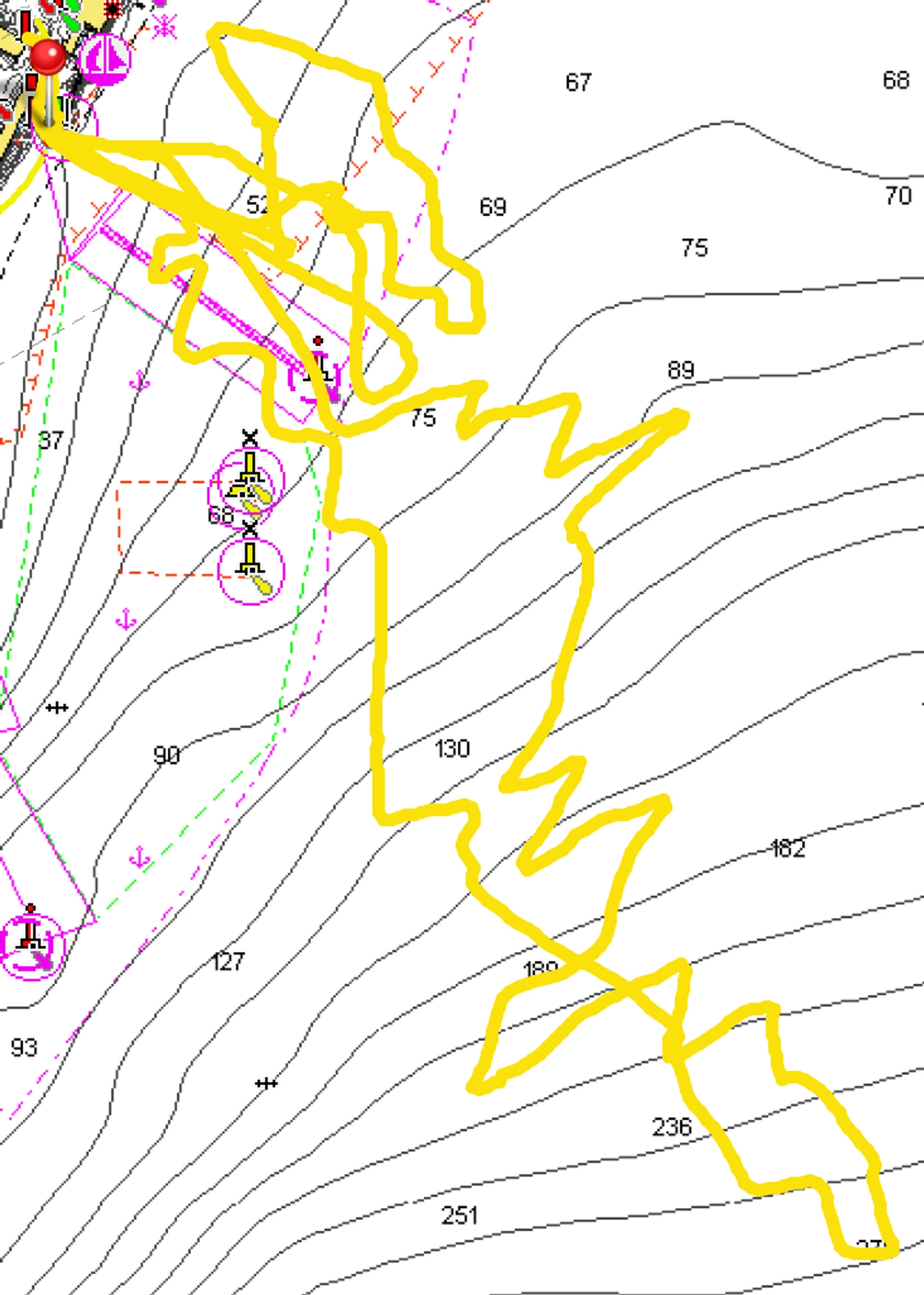
At 14:55 OERT stopped, and a technician came onboard to do some adjustments inside the front hatch. Five minutes later the training continued becoming more intense, increasing the number of tacks and reducing the time in between one and the next. As regards their tacking style, a pretty standard step-by-step technique could be identified with nothing ‘out of the box.’
Then a long downwind was carried out with special focus on the gybes, achieving a high fully-foiling percentage. In terms of technique, the variation on the course when bearing away into the gybe seemed very constant and slightly slower than what I am used to see, but possibly intentional to take advantage of the flat-water conditions to win some downwind VMG.
After the long downwind, at 16:05 there was a twenty-minute break in which there was a batteries replacement while the sailors and coaches had a conversation on the chase boat. Then, a short upwind-downwind was carried out doing five tacks and six gybes.
By 16:50 the wind had got a lot lighter, struggling to take-off. Ten minutes later, we were asked to take Glenn Ashby back to the base, as he had to take a flight that same evening. By 17:15 we were back in contact with the AC40 and found OE heading into the wind with a technician onboard with a tablet on his hands.
In a dying breeze, OERT did one last towing take-off and simulated a pre-start entrance followed by usual pre-start routine movements in a virtual box. At 17:45 the team decided to end the training and headed back to the base.
The AC40 entered the harbour at 17:55, lowered the sails right in front of the pier and docked at 18:15. Twenty minutes later, the boat was craned out of the water. Sebastian Peri Brusa – Recon on OE Racing Team
On Water Recon Report – NYYC American Magic Team: The American Magic Team was sailing with two boats again today. They rolled out their two AC40s, Magic and America, at 10:45 and 11:10, respectively. The boats both featured one-design foils across their starboard and port foil arms (previously they were running an LEQ design on starboard on both boats). They both had LiDAR image-capturing cameras installed and America still had the cameras that we saw on Monday on the side of the hull, a couple of meters forward from the foil arms.
At 13:00 they both docked out, towed by the chase boats to a training race area that was set almost 1 mile in front the Port Olímpic. Magic launched the MC-2 mainsail and a J1 one-design jib while America had the MC-4 mainsail and a J1 C-1 jib.
There was a very light breeze of 2-4 kn TWD 130º so the chase boats had to help the AC40 to start flying. They managed to sail for some minutes before the wind dropped and we had to wait until 14.45 until the wind started blowing more consistently 4-8 knots from TWD 150º. From here the sailing session was conducted as follows:
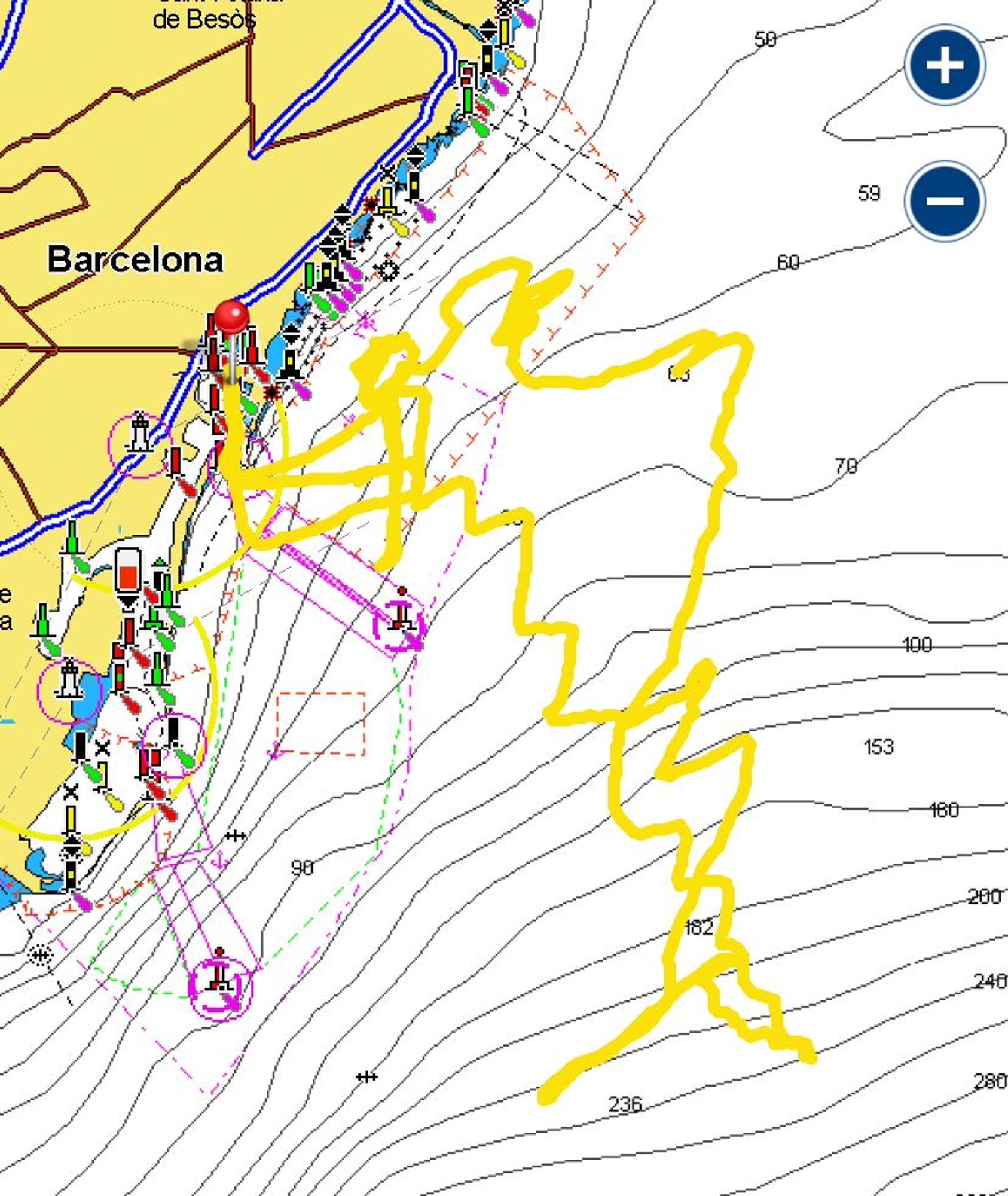
Stint 1 (14.45 to 16:00): The following exercises were executed:
- Test speed of the two boats together on a long port tack. Magic was leeward to America.
*Magic fell down after a tack and from here each one continued sailing separately. The recons followed America and could not see what Magic was doing as both boats got too far away one from each other.
- America went for a session of light wind manoeuvres and boat handling. They performed 10 tacks and 23 gybes (40% Touch & Go, 60% foil-to-foil).
After the last gybe America arrived back to the racing area in front Port Olympic where both boats joined again. They stopped to change batteries.
Stint 2 (16:15 to 17:00): After changing the batteries, the team tried to perform some pre-start training. It was hard as the wind was quite limited and they had to sometimes help them to foil with the chase boats. America managed to perform three complete starts while Magic just managed to get in one, in which they had a very nice battle on the way to the line with America. Magic seemed to have some problems with the foil arm system and had to stop. America also made a short stop and we saw them taking out a long batten from the main sail. We think they made a batten replacement on that stop.
Stint 3 (17:00 to 18:00). Magic kept trying to repair the problem that she was experiencing. At 17:30 h they decided to go back to port. America keep sailing in the marginal conditions for almost 30 minutes more. We felt like they were trying different sailing foil trims in the light conditions and at the same time testing the sails in the lower range. Dock in was completed at 17:45 h for Magic and 18:10 h for America.
In summary:
Despite the limited conditions and how hard it was to keep both boats sailing together, American Magic managed to get a very useful training session with:
- America foiling for 150 minutes and performed around 45 manoeuvres, 3 pre-starts, limited take-offs and quite a lot of sailing testing different settings on the lower range of wind.
- Magic sailing for around 100 minutes and performed a great training despite the issues experienced. Jose Piñana AC Recon
